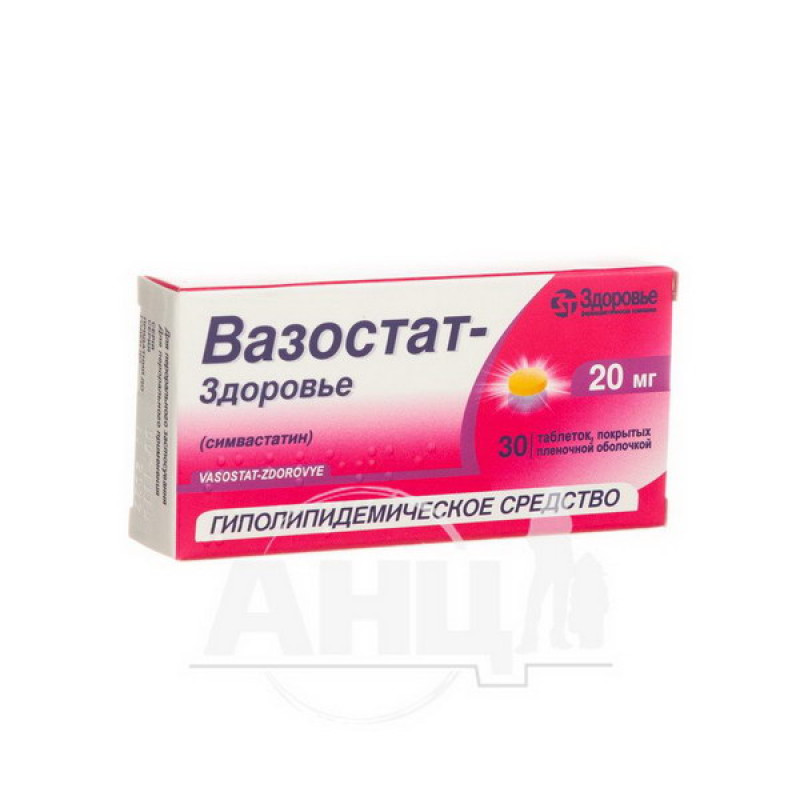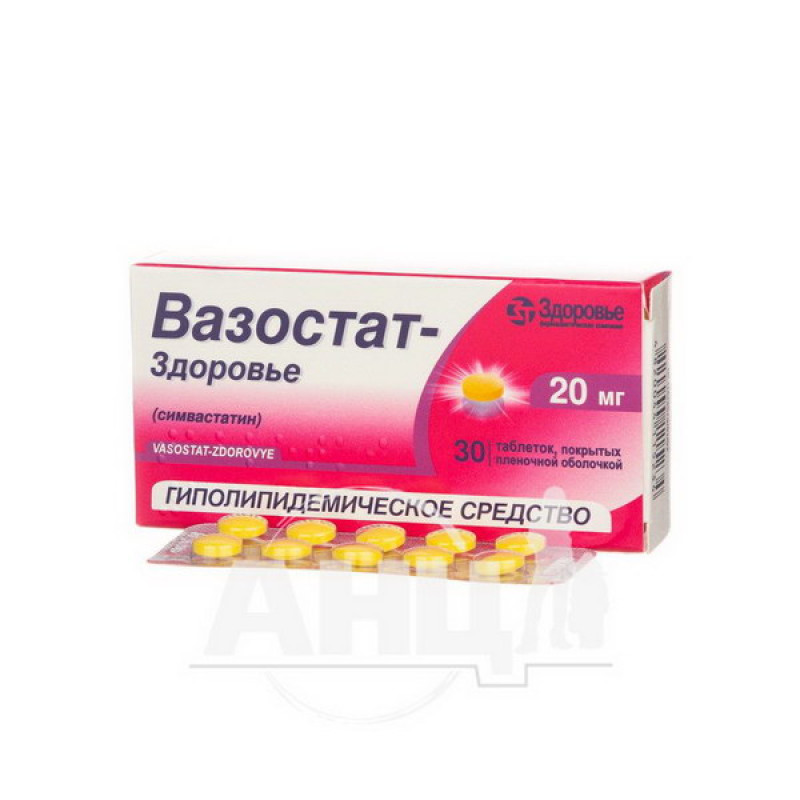Vasostat-Health film-coated tablets 20 mg No. 30

Pharmacological properties
The drug corrects lipid metabolism, being a prodrug. When taken orally, it is hydrolyzed to form an active metabolite that inhibits 3-hydroxy-3-methyl-glutaryl-CoA reductase (HMG-Co), an enzyme that catalyzes the reaction of mevalonate formation from HMG-Co. Due to the fact that the conversion of HMG-Co to mevalonate is an early stage of cholesterol synthesis, the use of simvastatin does not cause the accumulation of potentially toxic sterols in the body. The drug reduces the elevated level of cholesterol in the blood plasma, the concentration of LDL and VLDL, slightly increases the content of HDL. As a result, the ratio of HDL to LDL increases and cholesterol decreases. The drug reduces the concentration of triglycerides. In heterozygous familial and non-familial hypercholesterolemia, as well as in mixed hyperlipidemias, when the main disorder is an increase in cholesterol levels, the drug significantly reduces the concentration of total cholesterol and LDL. Vasostat-health is active in the ineffectiveness of diet therapy and other non-drug treatment methods. Long-term administration of 20-40 mg/day in patients with hypercholesterolemia and coronary artery disease reduces the progression of atherosclerotic lesions of the coronary arteries. The onset of action of the drug is noted after 2 weeks, the maximum therapeutic effect - after 4-6 weeks after the start of treatment with the drug. The effect is maintained during continued treatment. When therapy is discontinued, the content of cholesterol returns to the initial level.
The drug is well absorbed from the gastrointestinal tract (about 85%) when taken orally. The concentration of the drug and its metabolites, which are formed mainly in the liver, reaches a maximum in the blood plasma after 4 hours and decreases by 90% after 12 hours. Simvastatin and its biotransformation products are 95% bound to blood plasma proteins. The drug is excreted in the bile (about 85%) and urine (13%).
Indication
Primary hypercholesterolemia, combined hypercholesterolemia and hypertriglyceridemia, as well as hyperlipoproteinemia that is not amenable to correction by special diets and physical activity. In coronary artery disease - prevention of myocardial infarction, reduction of the risk of stroke and transient ischemic attacks, slowing the progression of coronary atherosclerosis.
Application
The usual starting dose is 10 mg/day once in the evening.
The drug is effective both as monotherapy and in combination with bile acid secretagogues. The dosage regimen and duration of treatment are set individually.
In mild or moderate hypercholesterolemia, the initial dose is 5 mg/day. If necessary, the dose can be increased, but not earlier than after 4 weeks of treatment; the maximum daily dose is 80 mg. If the LDL content is below 75 mg/dl (1.94 mmol/l) and the total cholesterol content is less than 140 mg/dl (3.6 mmol/l), the dose of the drug should be reduced.
In coronary artery disease, the initial dose is 20 mg/day once in the evening. If necessary, the dose is increased every 4 weeks to 40 mg/day. Correction of the dosage regimen, if necessary, should be carried out in the same way as in hypercholesterolemia. In patients with severe renal impairment (creatinine clearance less than 30 ml/min), the feasibility of prescribing the drug in a dose exceeding 10 mg/day should be carefully assessed. Since the drug is excreted by the kidneys in small quantities, there is no need to change the dose in patients with moderately severe renal impairment. In patients taking cyclosporines, fibrates, nicotinamide, the maximum daily dose of the drug is 10 mg/day.
Contraindication
Hypersensitivity to the components of the drug, liver failure, increased activity of hepatic transaminases, pregnancy and breastfeeding, age up to 18 years.
Side effects
On the part of the digestive system: abdominal pain, constipation, flatulence, nausea, diarrhea, dyspepsia, pancreatitis, vomiting, hepatitis, jaundice; possible pronounced and persistent increase in the activity of hepatic transaminases (more than 3 times the upper limit of normal), as well as LF.
From the side of the central and peripheral nervous system: headache, dizziness, muscle cramps, paresthesia, peripheral neuropathy.
Allergic reactions: rarely - angioedema, lupus-like syndrome, polymyalgia rheumatica, vasculitis, thrombocytopenia, eosinophilia, increased ESR, arthritis, urticaria, photosensitivity, fever, skin hyperemia, shortness of breath.
Dermatological reactions: skin rash, itching, alopecia.
Other: asthenia, muscle pain, anemia, rhabdomyolysis; in rare cases - myopathy.
Special instructions
Before starting the drug, a standard hypocholesterolemic diet is prescribed, which should be followed during the treatment period. It should be prescribed with caution to patients who abuse alcohol and/or have a history of liver disease.
Patients with muscle pain, increased muscle sensitivity, weakness and / or a pronounced increase in CPK activity should also discontinue treatment with the drug. The drug should be discontinued immediately in the presence of myopathy or other risk factors (simultaneous use of cytostatics, fibrates, niacin and antifungal drugs in high doses) that may predispose to the development of renal failure due to rhabdomyolysis.
Women of childbearing potential taking simvastatin should not attempt to become pregnant. If pregnancy is diagnosed during treatment, the drug should be discontinued and the woman should be apprised of the potential hazard to the fetus.
Interactions
The drug enhances the effect of indirect anticoagulants. Cytostatics, itraconazole, fibrates, nicotinic acid in high doses, used simultaneously with simvastatin, increase the risk of myopathy.
Overdose
Several cases of overdose with simvastatin have been reported, with none of the patients exhibiting any specific symptoms. The maximum dose taken is 450 mg. Treatment of overdose: gastric lavage, administration of activated charcoal; monitoring of vital body functions, including renal and hepatic function, and serum CPK levels.
Storage conditions
In a dry place, protected from light, at a temperature of 15-30 °C.
There are no reviews for this product.
There are no reviews for this product, be the first to leave your review.
No questions about this product, be the first and ask your question.






